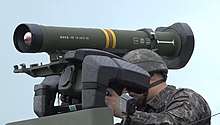AT-1K Raybolt
The LIG Nex1 AT-1K Raybolt (Korean: 현궁 "Hyungung") is a South Korean man-portable third-generation anti-tank guided missile built by LIG Nex1. It has fire-and-forget capability using an infrared imaging seeker and has a tandem-warhead to defeat explosive reactive armor. The Raybolt has a top attack and direct attack modes.[1] It is the first ATGM to be built by South Korea and entered mass production in June 2017.
| AT-1K Raybolt | |
|---|---|
 | |
| Type | Manportable fire-and-forget anti-tank missile |
| Service history | |
| Used by | See Operators |
| Wars | Yemeni Civil War |
| Production history | |
| Designer | Agency for Defense Development |
| Designed | 2007-10 |
| Manufacturer | LIG Nex1 |
| Produced | June 2017 - Present |
The Raybolt is positioned by its manufacturer as a competitor and peer with the American FGM-148 Javelin and Israeli Spike-MR ATGMs.[2]
The Raybolt was first shown publicly at the Indodefence 2014 exhibition[3] and at the IDEX 2015 exhibition.[4]
Development
Development began in 2007 and began in earnest in 2010, as South Korea's existing anti-tank guided missiles were reaching the end of their 25-year service life.[5] LIG Nex1's priorities during development were world-class performance, weight, export competitiveness through localization of core components, cost-efficiency, and reliability.[6] The development was not completely smooth, and for the first five years there were several failures with "Captive Flight Tests".[6] In a retrospective on the development of the Raybolt, one engineer assessed the greatest challenge as quality assurance.[6]
The Raybolt was developed to replace obsolete anti-tank weapons, such as recoilless rifles and TOW missiles.[7] South Korea's 1970s-vintage TOW missiles lacked tandem-warheads and would not be able to destroy modern North Korean tanks equipped with explosive reactive armor (ERA).[7]
The Raybolt is produced by LIG Nex1 in cooperation with South Korea's Agency for Defense Development, under the auspices of the Defense Acquisition Program Administration (DAPA).[1] About 95% of the Raybolt is made in South Korea.[8]
The Raybolt underwent successful test evaluations in Saudi Arabia in December 2013 and January 2014.[6] The Raybolt contract is expected to be worth 1 trillion won through till 2023.[8]
Components
The Raybolt's most notable feature is an imaging infrared seeker providing fire-and-forget capability. It also has a tandem-warhead and both direct attack and top attack modes.[1] The Raybolt uses a smokeless propellant and can be fired from within a building.[1] The Raybolt missile and Observation and Launch Unit (OLU) can either be vehicle-mounted or carried as a manpack by two men.[1] There are also discussions to mount the Raybolt on helicopters.[6] The OLU has day/night capability via a thermal sight.[1] The missile uses a soft launch to escape the barrel before activating the main flight motor.[5] It is scheduled to be acquired over the 2018-2022 timeframe.[7]
The Raybolt system weight about 20 kg (44 lb),[7] which its manufacturer describes as lighter than peers.[2] The Raybolt's range is 2.5[9] or 3 km.[8] The Raybolt's HEAT tandem warhead can penetrate 900 mm of RHA beyond defeating ERA,[10] which is described as "excellent performance" by DAPA.[7]
The Raybolt has been marketed to India.[11] Park Tae-sik, senior manager at LIG Nex1, also reports interest from South America.[5]
The missile can be carried by a two-man crew or fitted to fire from vehicles. The South Korean Army uses an anti-tank version of the Kia Motors 4×4 Light Tactical Vehicle (LTV) called the K-153C; the roof is equipped with a launcher turret with two missiles ready to fire and four additional missiles carried inside the vehicle.[9]
Launch platforms
- Man-portable launcher
- 4×4 K-153C ATGM carrier
- Rotem KW2 Scorpion Anti-Tank Vehicle
Combat History
The Raybolt was delivered to the Republic of Korea Armed Forces in 2017.[7] It will be used by the Korean Army and the ROK Marine Corps.[6]
In 2018, the Raybolt was used in the Yemeni Civil War by Saudi-backed forces against the Houthis.[12]
Operators
References
- "Medium Range Infantry Missile Raybolt" (PDF). www.lignex1.com. 26 September 2016.
- "S Korea's Raybolt ATGM Set To Compete Against Israeli Spike, US Javelin". www.defenseworld.net. 2 June 2017.
- https://www.armyrecognition.com/indodefence_2014_official_show_daily_news_coverage/lig_nex_1_showcases_chiron_portable_sam_and_raybolt_3rd_anti-tank_guided_missile.html
- https://www.janes.com/images/assets/201/49201/Day_1_-_ENGLISH.pdf
- Lee Seok-jong (22 October 2014). "빛과 같은 화살로 날아가 '꽝'대전차 임무 지형도가 바뀐다". kookbang.dema.mil.kr (in Korean).
- "Medium Range Infantry Missile Raybolt" (PDF). LIG Nex1 Magazine (in Korean). January–February 2014. pp. 6–15.
- Dagyum Ji (1 June 2017). "Seoul to mass-produce indigenous anti-tank guided missile: DAPA". NK News.
- Arthur, Gordon (7 December 2016). "Korea ignites Raybolt missile". www.shephardmedia.com. Hong Kong.
- South Korean Raybolt ATGM missile in service with Saudi Arabia army. Army Recognition. 1 October 2018.
- Kelvin Wong (12 September 2018). "DX Korea 2018: RoKA unveils 4×4 K-153C ATGM carrier - Jane's 360". Jane's International Defence Review. Archived from the original on 2018-09-12.
- "True Dream Partner - LIG Nex1". www.lignex1.com. 28 March 2016.
- Jeremy Binnie (26 June 2018). "South Korean Raybolt spotted in Yemen". IHS Jane's Defence Weekly. Archived from the original on 2018-07-02.
- "Opinion: South Korea – the next big defence exporter?". www.shephardmedia.com. 19 September 2018.